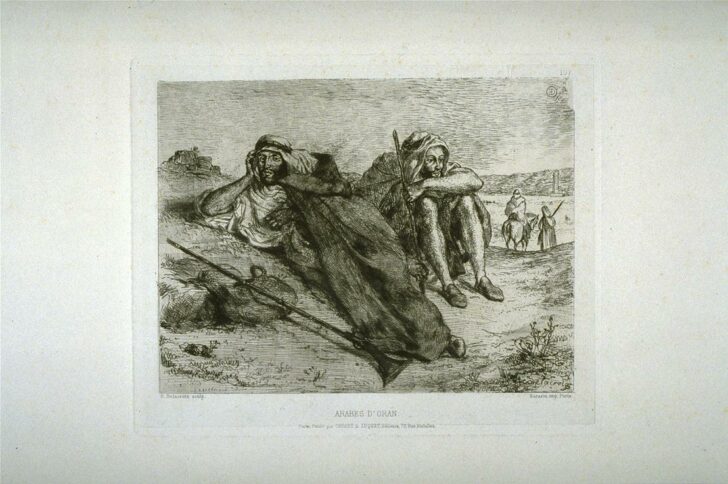Arabes d’Oran
Eugène Delacroix

Description
In 1832 Delacroix spent four months in Morocco, traveling with the Count de Mornay via Spain. During that expedition Delacroix made numerous drawings and watercolors, recording processions, harems, hunts, and other details of Moroccan life. These sketches were to fuel his imagination for decades and underlie many of his greatest Orientalist works.
Delacroix also saw the simplicity and nobility of the Arab culture as akin to the antique. He wrote, "Imagine, my friend, what it is to see, lying in the sun, walking the streets or mending shoes, men of consular type, each one a Cato or a Brutus . . . all in white like the senators of Rome and the Panathenaic procession of Athens." Here a pair of Arabs recline on the ground, resting during a hunt. This print evokes the languor and boredom that Delacroix captured so well in paintings such as The Women of Algiers in their Apartment.
Gallery Rotation Fall 2011
Eugène Delacroix
France, 1798–1863
Arabes d’Oran
1612
1833
Etching, drypoint, and roulette on chine collé
Museum purchase, 1953/2.25
From shortly after Napoleon’s (1769–1821) invasion of Egypt in 1799 until the early twentieth century, the allure of North Africa and Muslim countries east of the Mediterranean for European artists and patrons was manifest in exoticized images of harems and ferocious battles. In 1832 Delacroix traveled to Algeria and Morocco, making him one of the few artists for whom such works were based on actual experiences in the regions. Delacroix’s sketches from this trip provided imagery and subjects for many paintings and prints in subsequent years. This print shows two hunters from the Algerian city of Oran reclining on a hillock, wearily awaiting their prey.
Subject Matter:
Delacroix's visit to Algeria and Morocco in 1832 gave him direct experience with the exotic land and culture of North Africa. This scene depicting two hunters from the Algerian city of Oran shows both the dignified mien of the men as well as the accurately portrayed details of dress and weapons.
Physical Description:
This black and white print shows an outdoor setting with two men, one reclining and facing the viewer, the other seated with his legs drawn into his chest and gazing out to the right. They are dressed in robes and wear Arabic headdresses ("Guhtra"). There are rifles at their sides. In the background on the right are two men, one riding a horse, who walk toward a group of buildings in the distance. There is a French inscription below this scene that identifies the artist, title and publisher of the print.
Usage Rights:
If you are interested in using an image for a publication, please visit https://umma.umich.edu/request-image/ for more information and to fill out the online Image Rights and Reproductions Request Form.